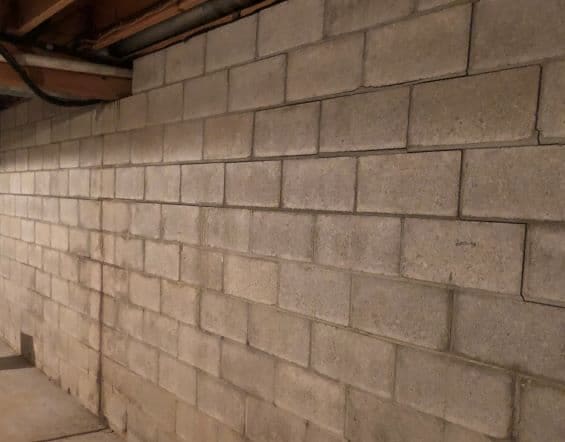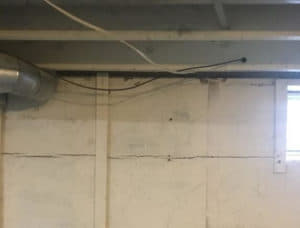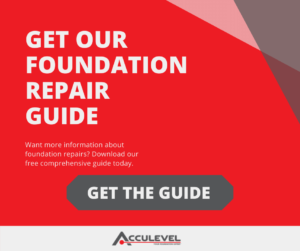What is Hydrostatic Pressure? And Why Does It Matter to Homeowners?

Originally posted 3/26/20, updated 1/21/22
Simply stated, hydrostatic pressure is important to homeowners because it can damage your foundation. Acculevel has been repairing foundations for more than twenty-five years, and we know firsthand what happens to a foundation when it’s struggling with water damage.
There is a gap between what homeowners know -and what they need to know- about hydrostatic pressure. This pressure can cause substantial damage to your foundation. We’re going to walk you through how hydrostatic pressure develops, what it can do to your home, and when you need to contact a professional.
The Formal Definition of Hydrostatic Pressure
hydrostatic pressure[ hī′drə-stăt′ĭk ]: The pressure exerted by a fluid at equilibrium at a given point within the fluid, due to the force of gravity. Hydrostatic pressure increases in proportion to depth measured from the surface because of the increasing weight of fluid exerting downward force from above.
I don’t know about you, but that definition does not make me feel better informed. In fact, the more I searched for hydrostatic pressure, the more complicated the results became. Search results gave me a wide range of research papers, scientific formulas, equations, even medical journals. (Blood pressure is hydrostatic pressure in your veins!)
So let’s try to break that formal definition down into more everyday terms.
How Hydrostatic Pressure Works
Stay with me, because I’m stating the obvious for a moment. There’s water in the ground around your house. It’s supposed to be there, there’s no way to remove all of it, and it wouldn’t be good for your foundation if it was removed. (Drought can also have a damaging effect on foundations, but that’s a topic for another time.)
Sometimes after heavy rain, or if you live in a high water table, the water collecting around your foundation can be a problem. This is especially true if you live near creeks, ponds, or other bodies of water where soil saturation is naturally high. If enough water accumulates, it starts to “push” or exert pressure against your home’s basement or crawlspace.
Essentially, the water wants to expand into the space that your home is occupying and your foundation isn’t allowing it. This is how hydrostatic pressure becomes a problem
Hydrostatic Pressure Can Cause Water Damage
The water pushing against your foundation is applying pressure, but as long as your foundation is secure, your home is stable. The problems occur when the foundation begins to weaken.
Your home’s foundation was built to support your home. It’s engineered to withstand weight and stress from above (vertical pressure). Hydrostatic pressure comes from the side (lateral pressure). Your foundation is not a dam and it’s not designed to function like one.
As an additional complication, your foundation is probably built out of concrete. This is a strong material that’s great for supporting a house- but it also happens to be porous.
This means water can seep into and through your walls.
What Are Signs of Hydrostatic Pressure?
Generally, the first sign a homeowner notices is a musty or damp smell. If you have a basement, you may see moisture or even water on your basement walls or floor.
Since people rarely enter crawl spaces, these homeowners won’t see any water intrusion. The first symptom for them is a stale, moldy odor that indicates mold is actively growing in their crawl space.
Humidity and water leaks are some of the results of hydrostatic pressure. They signal that water has saturated the foundation and found its way into your house. You may need basement waterproofing or crawl space encapsulation to address the water infiltration, which we discuss in more detail in other articles.
But if you have water getting into your home through cracks, you may have larger issues than just water damage.
Hydrostatic Pressure Also Damages Foundations
Some of the foundation issues caused by hydrostatic pressure are more structural. These structural problems occur when hydrostatic pressure increases until the foundation cracks under the strain.
If the pressure exerted remains high, the wall can begin to bow inward. Alternatively, the pressure may decrease as the ground dries out, only to surge back up with the next heavy rain. The point is: high hydrostatic pressure causes massive problems for homeowners, but at an unpredictable rate.
How Do You Know If Hydrostatic Pressure Is Damaging Your Foundation?
You may have water intruding into your home, but that’s not guaranteed. If your foundation is made of concrete blocks, water may be building up in the cavity inside the blocks instead.

The clearest sign that hydrostatic pressure is damaging your foundation is a wall that has cracked and is starting to bow. Not all cracks are signs of hydrostatic pressure; you’re looking for specific types of wall cracks.
Long Horizontal Cracks Indicate Hydrostatic Pressure
Many foundation cracks have an unpredictable pattern or shape. These aren’t good for your home’s stability, but they’re less likely to cause a wall to bow or collapse. But if the crack in your foundation is long and runs in a horizontal line, you have a big problem.

This photo was taken by an Acculevel project advisor during a free in-home assessment.
You may see this type of crack in poured concrete or concrete blocks. This crack is showing where the pressure pushing against the wall has created a weak point.
Stair-Step Cracks Also Indicate Hydrostatic Pressure
The other style of crack that indicates your wall has been structurally compromised is a stair-step or zig-zag shape. These cracks only appear in walls made of block or brick, because the crack is forming along the mortar joints.

This photo was taken by an Acculevel project advisor during a free in-home assessment. This wall shows both types of cracks.
How Do You Repair Hydrostatic Pressure Damage?
If you have a wall that is cracking horizontally, or stair-stepping along the blocks, you need to take action promptly. If your walls are actually bowing inward, it’s critical to take immediate action.

BEFORE: This photo was taken by an Acculevel project advisor during a free in-home assessment.
A bowing wall that is left alone will become a breaking or collapsing wall. These create major instability, damage throughout your home, and are very expensive to repair. Once a wall collapses, your home may no longer be safe for habitation; living in a hotel is costly and inconvenient.
In the photo above, you can see there are both horizontal and stair step cracks. The long horizontal crack (four blocks down from the top) is beginning to lean inward slightly. Because the wall is bowing less than 2 inches inward, it can be repaired with carbon fiber straps.
Carbon fiber straps are a non-invasive home repair that can be done from inside your basement. They are the least expensive repair method for bowing walls. In the photo below, you can see the same home, after repairs have been made.
The cracks have all been sealed with epoxy to prevent water intrusion, and carbon fiber straps have been placed every four feet along the bowing wall. Both types of repairs can be painted over, if you plan to use the space and want a more aesthetically pleasing look.

AFTER: This photo was taken by an Acculevel crew member after repairs were made (same home).
If your walls are bowing more than 2 inches, you will need either wall anchors or helical tiebacks. The linked article explains how each of these solutions work, when they should be used, and what they cost. We want to stress again: earlier diagnosis and repair means a less invasive and expensive repair.
Do You Have More Questions About Foundation Problems?
We have developed a comprehensive homeowner’s guide to foundation repairs. This is a free resource available to anyone who wants to know more about their home. In it, we address common foundation problems, what causes them, how they’re repaired, how you can reduce the risk (or avoid them!), and the associated costs of these options.
Is Hydrostatic Pressure Damaging Your Home?
If so, you should find an experienced local foundation company, and make an appointment. Most foundation repairs can be done year-round regardless of the weather, so please do not put off these repairs for a different season or warmer temperatures. This is especially true if you have an actively bowing wall. Waiting too long can cause serious structural damage.
Before signing a contract, we recommend that you should verify the company is reputable, insured, and accredited by the Better Business Bureau.
You are also welcome to use our checklist of questions to ask a contractor. This is another free resource we developed to help homeowners be well-informed about business practices when meeting with repair contractors.
If you live in Indiana or the surrounding states, contact Acculevel. Established in 1996, we specialize in foundation repairs and waterproofing. We provide free in-home assessments, performed by experienced project advisors.
Your advisor will meet with you to discuss signs you’ve noticed, evaluate your home, and develop a whole-home solution to address the issues. As a team, you’ll determine the best course of action to keep your home strong and healthy for years to come.
 |  |
